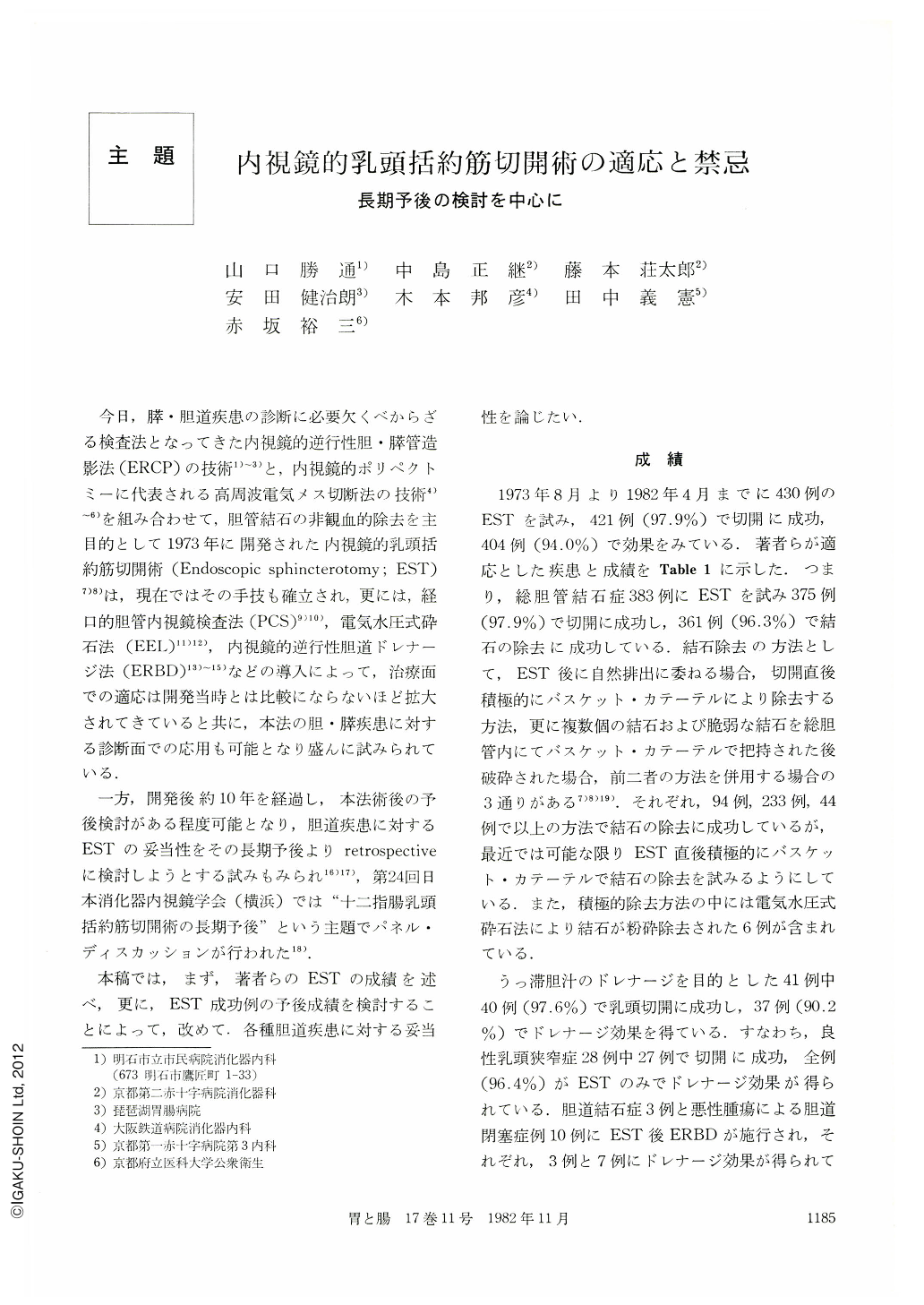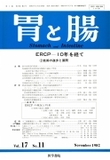Japanese
English
- 有料閲覧
- Abstract 文献概要
- 1ページ目 Look Inside
今日,膵・胆道疾患の診断に必要欠くべからざる検査法となってきた内視鏡的逆行性胆・膵管造影法(ERCP)の技術1)~3)と,内視鏡的ポリペクトミーに代表される高周波電気メス切断法の技術4)~6)を組み合わせて,胆管結石の非観血的除去を主目的として1973年に開発された内視鏡的乳頭括約筋切開術(Endoscopic sphincterotomy;EST)7)8),現在ではその手技も確立され,更には,経口的胆管内視鏡検査法(PCS)9)10),電気水圧式砕石法(EEL)11)12),内視鏡的逆行性胆道ドレナージ法(ERBD)13)~15)などの導入によって,治療面での適応は開発当時とは比較にならないほど拡大されてきていると共に,本法の胆・膵疾患に対する診断面での応用も可能となり盛んに試みられている.
一方,開発後約10年を経過し,本法術後の予後検討がある程度可能となり,胆道疾患に対するESTの妥当性をその長期予後よりretrospectiveに検討しようとする試みもみられ16)17),第24回日本消化器内視鏡学会(横浜)では“十二指腸乳頭括約筋切開術の長期予後”という主題でパネル・ディスカッションが行われた18).
Introduction: In 1973, we divised endoscopic sphincterotomy (EST) for the purpose of non-operative transpapillary biliary drainage and the treatment of stones in the common bile duct. Now EST is covering the diagnosis and treatment of almost all diseases of biliary tract due to technical establishment, instrumental improvement and introduction of new techniques. As one of therapeutic approaches with EST, ERBD (endoscopic retrograde biliary drainage)has been recently developed. This procedure is applied to patients with a malignant bile duct obstruction in order to relieve the jaundice by the endoscopic insertion of a biliary endoprosthesis. We have experienced 18 cases of ERBD which included six cases of ERBD after PTCD. The excellent drainage was obtained in 14 cases.
In this paper, we will discuss the propriety of EST to biliary diseases by a follow-up study.
Subject and Methods: From August 1973 to April 1982, we performed 430 cases of EST. In 421 cases (97.9%) of successful incision of the papilla Vateri, 404 cases (94.0%) showed a remarkable effect.
Our cases of EST were indicated in 383 cases of stones in the biliary tract, 41 of cholestasis from various causes and six for peroral choledochoscopy with biopsy.
We requested the report from the attendant doctors who performed 108 cases of this one year. As to successful 313 in 322 cases performed before one year, we made inquiries to both patients and attendant doctors.
Results: We received reports from all the attendant doctors of 108 cases of this one year, while we were able to collect the questionnaire only from 247 of 313 cases performed before one year. The questionnaire revealed that three patients in the second year and other three patients in the third year after EST died. There was no cause of death directly related with EST, that is, three of apoplexy, one of liver cirrhosis, one of pancreatic cancer and one of abdominal tumor.
Among patients with stones in the common bile duct, there were 110 with the gallbladder with stone (63 cases) or without stone (47 cases), and 132 who had been cholecystectomized at the time of EST, showing residual or recurrent stones in the common bile duct or who were cholecystectomized after EST.
In 247 cases answering the questionnaire, 34 (13.8%) complained of some symptoms after EST. Among them, 11 were found to have some complications. The remaining 23 cases with symptoms consisted of 18 without the gallbladder, four with the normal gallbladder and one with gallbladder stone. The subjective symptoms were temporary abdominal pain or fever.
Eleven cases with complications consisted of five cases of recurrent stones after EST, three of cholecystitis and three of cholangitis.
All five cases of recurrent stones were male. The initial EST to these five cases was done due to recurrent stones after cholecystectomy in three cases (including a case associated with intrahepatic stones) and poor risk for the surgery in two cases (including a case associated with gallbladder stone). The incision of the papilla Vateri was not full in four of five cases. A case with a parapapillary diverticulum, however, was incised sufficiently.
All three cases with cholecystitis after EST were leaving stones in the gallbladder, amounting to 2.7% of the cases with the gallbladder and to 6.4% of 47 cases with gallbladder stones. The incision of the papilla was sufficient in all three cases, but stones were found in the cystic duct as well as in the gallbladder.
Other three cases had ERCP because of intermittent fever and abdominal pain with slightly abnormal liver functions after EST, but no recurrent stone was proven. Thus, they were diagnosed as cholangitis after EST. Their symptoms had disappeared at latest by one and a half years after their onset.
All complications occurred within three years after EST except a case of recurrent stone in five years after EST.
From the inquiries to the attendant doctors of all 430 cases, the early complications within one and a half months after EST were reported in 12 cases, and one of them died of suppurative cholangitis.
Consequently, we have experienced 23 cases of post-EST complications including one fatal case in 430 performances. The rate of the complications and the fatality rate to 421 of a successful cases of which we had some informations after EST, were 5.5% and 0.2 respectively.
Conclusions: EST gives the sufficient result in diagnosis and treatment of various diseases in the biliary tract. Furthermore, EST was found to be a safe procedure from the low rates of complications and fatality. At the performance, however, the skillfulness of endoscopic techniques including diathermy is required because a severe complication could be induced. And we must follow up the patients carefully at least three years after EST.

Copyright © 1982, Igaku-Shoin Ltd. All rights reserved.


